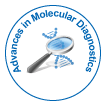Review Article
Clinical Next-Generation Sequencing for Somatic Mutation Detection- Advancements and Commercialization Strategies
| Andrew Hesse, Christopher Chen and Honey V. Reddi* | |
| Transgenomic, Inc, 5 Science Park, New Haven, CT, USA 06477. | |
| Corresponding Author : | Honey V. Reddi Transgenomic, Inc, 5 Science Park, New Haven, CT, USA 06477 Tel: 203-907-2290 E-mail: honeyreddi@gmail.com |
| Received: September 29, 2015; Accepted: October 24, 2015; Published: October 27, 2015 | |
| Citation: Hesse A, Chen C, Reddi HV (2015) Clinical Next-Generation Sequencing for Somatic Mutation Detection – Advancements and Commercialization Strategies. Adv Mol Diag 1:101. doi:10.4172/AMD.1000101 | |
| Copyright: © 2015 Hesse A, et al. This is an open-access article distributed under the terms of the Creative Commons Attribution License, which permits unrestricted use, distribution, and reproduction in any medium, provided the original author and source are credited. | |
| Related article at Pubmed, Scholar Google | |
Abstract
Advancements in next-generation sequencing, variant-calling software, and mutation enrichment are facilitating the detection of rare genetic variants. In doing so, these methods have enabled identification of somatic disease, and more specifically cancer, representing as little as 0.01% of bulk genetic material. This improved sensitivity reduces false negative results, and in cancer, allows earlier detection. Such early detection will greatly improve monitoring and treatment of these diseases, especially in the context of liquid biopsies. This review aims to encapsulate the growing spectrum of technology and software currently being utilized to improve the sensitivity of somatic variant detection. Furthermore, industry adoption of these techniques will be summarized.

 Spanish
Spanish  Chinese
Chinese  Russian
Russian  German
German  French
French  Japanese
Japanese  Portuguese
Portuguese  Hindi
Hindi